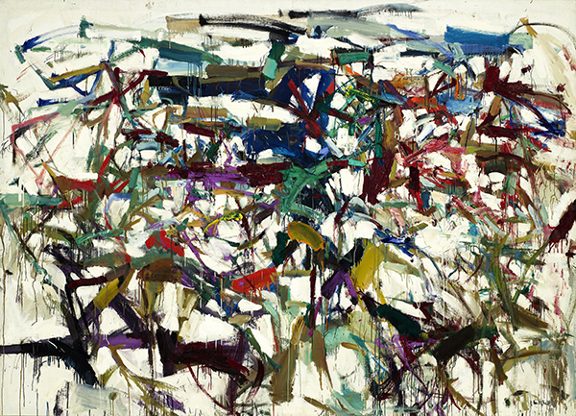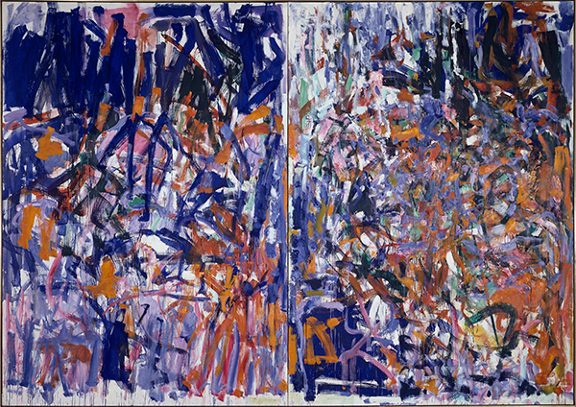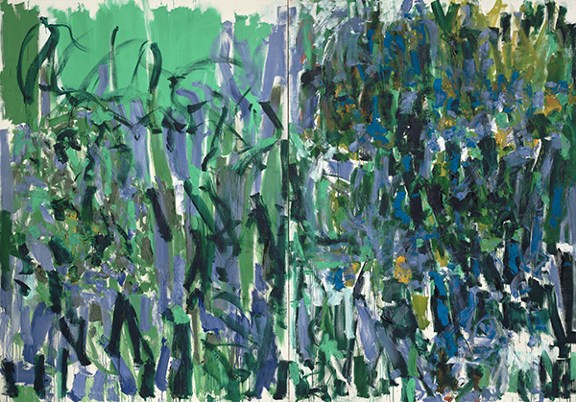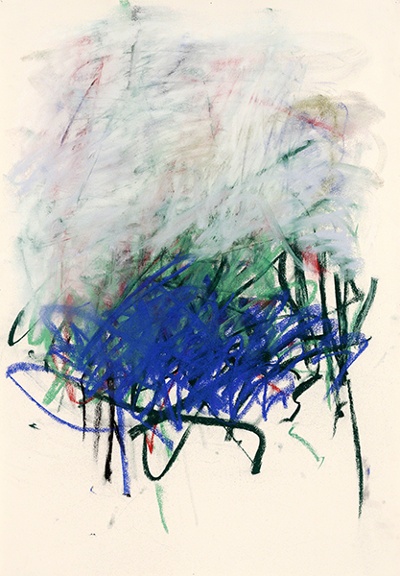Gem of the Month: Joan Mitchell
As a fiend for color in painting, it will come as no surprise that I absolutely worship the work of Abstract Expressionist painter Joan Mitchell. It’s very confusing to me—no, it’s irritating to me that the women associated with this movement (of the so-called New York School) did not receive as much attention as their male “star” colleagues during the heyday of the movement (ca. late 1940s–1950s). Mitchell herself actually achieved a modicum of success with exhibitions before she left New York for good in 1959.
 |
| Joan Mitchell (1925–1992, U.S.), Ladybug, 1957. Oil on canvas, 78" x 107 7/8" (198 x 274 cm). Courtesy of the Museum of Modern Art, New York. © 2023 Estate of Joan Mitchell. (MOMA-P2535) |
Mitchell defined the works of her mature period as “expressionist landscapes.” Although excited with the gestural nature of action painting, she rejected the New York School's notion of non-narrative, all-over painting that typically eschewed specific subject designation. Inspired by nature, Mitchell's works were not meant to represent nature, but rather represent what she took away from her encounters with nature.
Ladybug was painted while Mitchell still lived in New York. Typical of Mitchell’s work of the late 1950s, it is characterized by a thick network of horizontal slashes of paint integrated with a cool, multi-layered white ground. She alternated her technique of slashes of pure, unblended color with paint strokes that blended together on the canvas. The overall integration of pure and blended color creates a sense of depth in nonobjective painting.
Mitchell once remarked that the freedom of her canvases was strictly controlled. Such works were documents of the feelings that experiences in nature left her with. In Ladybug, it is tempting to view the two swipes of brilliant carmine red in the lower foreground as the titular subject.
 |
| Joan Mitchell, Weeds, 1976. Oil on canvas, two panels, 110 4/16" x 157 ½" (280.6 x 400.1 cm). Courtesy of the Hirshhorn Museum and Sculpture Garden, Smithsonian Institution, Washington, DC. © 2023 Estate of Joan Mitchell. (SI-388) |
Dividing her time between New York and Paris during the 1950s, Mitchell moved to France permanently in 1959. This bold step moved her away from her success in New York and its burgeoning art world. Paris offered a different atmosphere and a different group of friends and artists. In 1967, Mitchell settled in Vétheuil, a village 37 miles (60 km) northwest of Paris.
Mitchell often painted diptychs (two-part paintings) based on what she saw in her gardens outside of Paris, including weeds. Weeds are suggested in this composition by the slashing brushstrokes of yellow ochre tinged with venetian red in the midst of brilliant cobalt blue and violets. Weeds was first exhibited with other works that intimated tangled underbrush, plants, and stems in 1976 at the Xavier Fourcade Gallery in New York.
 |
| Joan Mitchell, No Rain, 1976. Oil on canvas, two panels, 110" x 157 1/16" (279.5 x 400.4 cm). Courtesy of the Museum of Modern Art, New York. © 2023 Estate of Joan Mitchell. (MOMA-P1600) |
Although she adapted the visual vocabulary of Abstract Expressionism, there is an underlying structure to Mitchell’s paintings that veers away from the style’s emphasis on subconscious spontaneity. Like her contemporary, abstract painter Helen Frankenthaler (1928–2011), much of Mitchell’s work alludes to landscape. The setting of Vétheuil can also be found in many landscapes by Claude Monet (1840–1926).
No Rain is Mitchell's impression of a garden in need of water. Using the slashing, short brushstrokes of Abstract Expressionism, Mitchell builds layer upon layer of color to achieve an overall impression of a dry garden. Luxuriant long strokes of green and blue contrast with short daubs of yellow and yellow green to counterpoint flourishing and declining plants.
In this work, Mitchell engaged with the spirit of some of Vincent van Gogh’s (1853–1890) paintings. This can be seen in the controlled combination of vigorous diagonal, straight, slashing brushstrokes, and even the palette. It brings to mind van Gogh’s four versions of Rain painted in 1889 while he was at the asylum in Saint-Rémy-de-Provence. Mitchell may have referred to those works again when she painted Rain in 1989.
 |
| Joan Mitchell, Untitled, 1992. Pastel on paper, 29 ½" x 21 ¾" (75 x 55.2 cm). Courtesy of the Museum of Modern Art, New York. © 2023 Estate of Joan Mitchell. (MOMA-P0097) |
In pastels, Mitchell's abstractions are free from representative detail with a variety of marks, smears, and gestures that unite to suggest landscape. Mitchell dealt with color as pure pigment with pastels. Although pastels smear easily and the dust gets on everything, the medium and delivery tool are one in the same, capable of long, expressive individual lines of pure color. With the additions of smears, fingerprints, and erasures, Mitchell's pastels are at once fiercely exuberant gestural abstraction and also ghostly suggestion, where the more solid forms contrasting with the softer ones intimate space.
Like most of her pastels of the 1990s, Untitled is comprised of an economy of form that enables the colors to float on the blank background. Works like this, with the push and pull of pure color and blended higher value colors hint at various aspects of nature as well as atmosphere. The work conjures up the sight of a mist-shrouded meadow after a spring rain.
Born in Chicago, from an early age Mitchell showed an interest in and love of painting, art, and poetry. As a poet, editor, and writer, Mitchell’s mother, Marion Strobel Mitchell, influenced her interest in poetry. Her father, James Herbert Mitchell—a doctor—brought her to museums in the city. After studying art and English at Smith College from 1942 to 1944, Mitchell transferred to the School of the Art Institute of Chicago in 1944 to study painting.
In 1947, Mitchell moved to Brooklyn to study with pioneer German American abstractionist Hans Hofmann (1880–1966). Although she ultimately only attended one of his classes, being in New York introduced her to the ideas and artwork of the New York School, which was dominated by the Abstract Expressionists. In 1948, Mitchell left for Paris on the James Nelson Raymond Foreign Traveling Fellowship. As her artwork continued to evolve during her time abroad, her paintings, Cubist cityscapes, interiors, and figures became progressively more abstract.
Mitchell returned to the School of the Art Institute of Chicago in 1949, where she earned an MFA (1950). In 1950, she moved to New York, where she became friends with painters such Willem de Kooning (1904–1997) and Franz Kline (1910–1962). She joined the male-dominated Artists’ Club in Greenwich Village, where Abstract Expressionism was discussed and supported. In 1951, Mitchell’s work was included in The Club’s exhibition 9th Street: Exhibition of Painting and Sculpture.
Marking the true beginning of her career as an artist, Mitchell had her first solo New York City exhibition at The New Gallery in 1952. The exhibition's critical success led to yearly exhibitions at the Stable Gallery. Through the 1950s, her work became more confident. She rejected the pervasive attention to automatist painting among the Abstract Expressionists, insisting on content rather than simply process.
Correlations to Davis programs: Explorations in Art 2E Grade 1: 4.5; Explorations in Art 2E Grade 5: 2.4; Experience Art: 4.1; A Personal Journey 2E: 5.4; Discovering Art History 4E: 17.1


Comments